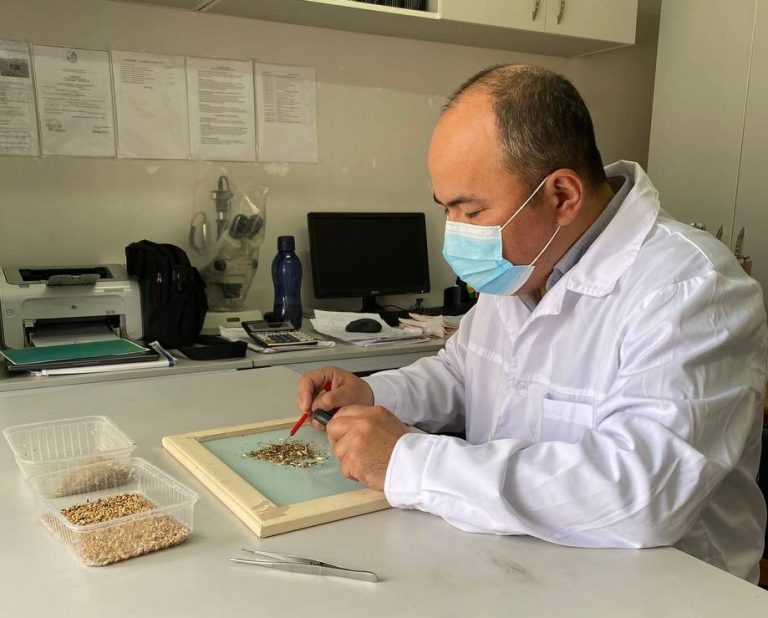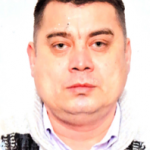Herbology Laboratory
Laboratory Activity
- Development of international relations, interaction with academic, research and production organizations for joint research;
- Development of new and improvement of existing experimental techniques based on laboratory instruments and equipment;
- Scientific and methodological support and training of specialists in the field of plant protection and quarantine on the identification, identification, localization and elimination of especially dangerous and quarantine weeds;
- Development of recommendations, guidelines and manuals for individuals and legal entities on planning and conducting sewn-up activities from segetal flora in agrophytocenoses;
- Provision of paid consulting services, conducting advanced training courses, training seminars and research work;
- Introduction of scientific and practical developments of the laboratory into production.
Priority areas of activity
- Development of rational and environmentally safe technologies for the protection of crops from weeds with the use of new generation herbicides;
- Development of comprehensive protective measures against quarantine weeds with limited distribution on the territory of the Republic of Kazakhstan;
- Study of the relationship between cultivated and weed plants in agrocenoses, determination of thresholds and critical periods of weed harmfulness;
- Development of systems for the rational use of herbicides in an integrated system of protection of major crops for various natural and climatic zones of the republic;
- Development of an information database on biology, phenology, distribution and harmfulness of especially harmful and quarantine weeds of the Republic of Kazakhstan;
- Improvement of methods and technologies of phytosanitary monitoring with the use of geoinformation technologies and remote sensing data of agricultural lands by unmanned aerial vehicles equipped with appropriate cameras, control devices, collection, transmission and processing of information;
- Development of experimental and experimental samples of specialized agricultural machinery for the control of root weeds;
- Formation of herbarium collection of weeds as the basis of diagnostic base of phytosanitary analysis;
- Training of highly qualified scientific personnel, publishing books, atlases and articles.
Services provided
- Consultations to agricultural producers on the issues of segetal flora in agrophytocenoses.
- Dissemination of knowledge (lectures, seminars, field days) on the problems of weeds.
- Conducting registration and production tests of herbicides in crops of various agricultural crops.
- Development of scientifically-based protective measures against particularly harmful and quarantine weeds.
- Herbological monitoring and development of effective, rational schemes of crop protection from weeds
- Conducting laboratory serological analysis.
Laboratory achievements
- Scientific, practical and methodological developments of the laboratory are being implemented in many regions of the republic, they are used by the service of the RSE “Phytosanitary” and its regional branches, the State Institution “Republican Methodological Center for Phytosanitary Diagnostics and Forecasts”, which has regional branches, the “Republican Quarantine Laboratory” including regional divisions, as well as other institutions related to the nature of work related to protection and plant quarantine.
- An innovative technology has been developed to combat the creeping bittern in steam fields, including a three-tier cultivator-planar cutter with equipment for intra-soil application of herbicides (KPTG-2.8), which allows, compared with single-operation units, to obtain a reduction in specific capital investment by 25-30%, labor costs by 75-80%, operating costs by 35-40%.
- Since the establishment of the laboratory, the staff has published 2 textbooks, 6 recommendations, 1 methodological instruction, more than 30 scientific papers. The analysis of phytosanitary risk of 9 types of weeds was carried out. 6 innovative patents of the Republic of Kazakhstan have been obtained.

- Utility model patent No. 26335. “A way to control weeds on a podsolnik”. Authors: Boltaev M.D., Badaev E.M., Ishkibaev K.S.
- Utility model patent No. 26332. “A way to combat the creeping bittern.” Authors: Sagitov A.O., Boltaev M.D., Badaev E.M.
- The population of bark beetles (Scolytinae) and their entomophages on endemic spruce in the Zaili Alatau Mukhamadiyev, N., Bolat, J., Koigeldina, A., Mengdibayeva, G. Ecology, Environment and Conservation, 2020, 26(3), стр. 1189–1192
- The number of main species of bark beetles (Scolytinae) and protective measures in the mountain forests of the zaili alatau Mukhamadiyev, N., Bolat, J., Koigeldina, A., Mengdibayeva, G. Ecology, Environment and Conservation, 2020, 26(3), стр. 1166–1169
- Structure of a crop and productivity of a castor-oil plant depending on periods of sowing, norms of sowing and seeding depth Koigeldina, A.E., Nurgasenov, T., Rahmetolaevich, B.S. Biosciences Biotechnology Research Asia, 2015, 12(1), стр. 51–57
- The basic techniques of cultivation of the castor in the foothill zone of almaty regionKoigeldina, A.E., Nurgasenov, T., Arystangulov, S.S. Biomedical and Pharmacology Journalthis link is disabled, 2014, 7(2), стр. 563–566
“Development and improvement of integrated protection systems for fruit, vegetable, grain, fodder, legumes and quarantine plants”.
Staff

Head of the Herbology Laboratory
email: bek.jan72@mail.ru
Activity
1994 – 2012 – Lecturer of the Department of Agriculture and Crop Production of KazNAU;
2010-2012 Deputy Dean of the Faculty of Agronomy, Agrochemistry and Plant Protection of KazNAU;
2013 – 2020 – Senior Researcher at the Herbology Laboratory of ICFLA LLP “KazNIIZiKR im. Zhazken Zhiembayeva”.
From January to March 2021 – Deputy Chairman of the Management Board for General Issues of AGROPARK ONTUSIK LLP.
From March to October 2021 – Head of the Scientific Department of AGROPARK ONTUSIK LLP.
From October to December 2021 – Deputy Chairman of the Management Board for the implementation of innovative LLP “AGROPARK “ONTUSIK”.
Since January 2022 – Head of the Herbology Laboratory of KazNIIZiKR LLP. Zhazken Zhiembayeva”.
Scientific interests
Herbological research on the problems of quarantine and especially dangerous weeds.
Current projects
“Development and improvement of integrated protection systems for fruit, vegetable, grain, fodder, legumes and quarantine plants”.
Main publications
- Ермекбаев Б.У., Башкараев Н.А., Баядилов К.О. Биологические особенности роста и развития горчака ползучего в условиях юго-востока казахстана. Международная научная конференция «Становление и развитие науки по защите и карантину растений в Республики Казахстан», посвященный 60-летию основания института и 100-лети научных исследований по защите растений в Казахстане. Алматы, 2018. С.276-280
- Есимов У.О., Ермекбаев Б.У., Асканбаев С.С. Борьба с сорняками на посевах кукурузы. Международная научная конференция «Становление и развитие науки по защите и карантину растений в Республики Казахстан», посвященный 60-летию основания института и 100-лети научных исследований по защите растений в Казахстане. Алматы, 2018. С. 289-294
- Есимов У.О., Ермекбаев Б.У., Асканбаев С.С., Башкараев Н.А. Биологическая эффективность гербицидов, применяемых в посевах сои ТОО «Байсерке-Агро». Международная научно-проктической конференции, «Наука, производство, бизнес: современное состояние и пути инновационного развития аграрного сектора на примере Агрохолдинга «Байсерке-Агро»», посвященный 70-летию Досмухамбетова Темирхана Мынайдаровича. Алматы, 2018. С. 272-276.
- Есимов У.О., Ермекбаев Б.У. Қытай бұршағы дақылын арамшөптерден қорғау. Международная научная конференции «Защита растений и экологическая устойчивость агробиоценозов», посвященный 100-летию со дня рождения доктора с-х. наук, профессора Ж.Т. Джиембаева. Алматы, 2018. С.209-211.
- Ержанова М.Е., Ермекбаев Б.У. Опасный карантинный вредитель-картофельный жук-блошка клубневая, EPITRIXTUBERIS. Международная научная конференции «Защита растений и экологическая устойчивость агробиоценозов», посвященный 100-летию со дня рождения доктора с-х. наук, профессора Ж.Т. Джиембаева. Алматы, 2018. С.400-402.

email: boltaevmar@mail.ru
Activity
22.05.2006 – Senior laboratory assistant of the Weed Control Department of the DGP “Research Institute of Plant Protection”;
02.05.2007 – Junior researcher of the Department of Herbology, DGP “Research Institute of Plant Protection”;
01.04.2008 – Manager for Communications and Media of the Scientific and Analytical Department, LLP “Kazakh Research Institute for Plant Protection and Quarantine”;
01.04.2010 – Junior Researcher of the Plant Quarantine Department, Kazakh Research Institute of Plant Protection and Quarantine LLP;
02.05.2012 – Senior researcher at the Herbology Laboratory, LLP “Kazakh Research Institute for Plant Protection and Quarantine named after Zh. Zhiembayev”.
05.01.2021 – Leading researcher of the Herbology Laboratory, LLP “Kazakh Research Institute for Plant Protection and Quarantine named after Zh. Zhiembayev”.
Scientific interests
Herbological and entomological research, plant quarantine, geoinformation technologies
Current projects
“Development and improvement of integrated protection systems for fruit, vegetable, grain, fodder, legumes and quarantine plants”.
Main publications
- Болтаев М.Д., Камбулин В.Е., Хидиров К.Р.,Есимов У.О., Башкараев Н.А. Результаты применения геоинформационных технологий и беспилотного летательного аппарата для выявления личинок мароккской саранчи. Международный научный журнал-приложение Республики Казахстан “Ізденіс / Поиск”, №2/2020, С 222-228
- D. Boltayev, V. E. Kambulin, Zh. B. Niyazbekov, U. O. Yessimov, N. A. Bashkarayev, A. M. Uspanov. Experience of practical application of unmanned aerial vehicle for monitoring Moroccan locust numbers in Kazakhstan. EurAsian Journal of BioSciences 14: 6979-6981 (2020)
- Шамуратов Д.А., Ниязбеков Ж.Б., Болтаев М.Д. Совершенствование методов мониторинга стадных видов саранчовых с использованием беспилотного летательного аппарата.Сборник Защита растений от вредных организмов: Материалы IX междунар. научн.-практ. конф., Краснодар, 2021 год. – С. 408-410
- Шамуратов Д.А., Ниязбеков Ж.Б., Болтаев М.Д., Есимов У.О. Башкараев Н.А. Эффективность биопрепаратов против стадных видов саранчовых вредителей в Казахстане.Сборник Защита растений от вредных организмов: Материалы IX междунар. научн.-практ. конф., Краснодар, 2021 год. – С. 411-413
- Успанов А.М., Болтаев М.Д., Камбулин В.Е., Ниязбеков Ж.Б. Применение геинфорационных технологий и беспилотных летательных аппаратов для выявления мароккской саранчи. ж. Защита и карантин растений. – М:. –№5. – 2021. – С. 26-30

Junior Researcher
email: beisekina96@bk.ru
Activity
2021-2022 – Specialist of the Youth Department, Kazakh National Agrarian Research University.
From 2022 to the present – Junior researcher at the Herbology Laboratory of KazNIIZiKR LLP. Zhazken Zhiembayeva”.
Scientific interests
Geological research on the problem of quarantine and especially dangerous weeds.
Current projects
“Development and improvement of integrated protection systems for fruit, vegetable, grain, fodder, legumes and quarantine plants”.
Main publications
- Бейсекина Б.М. «Түркістан облысы жағдайында жеміс ағаштардың ақ ұнтақ ауруының даму ерекшеліктері жəне заманауи фунгицидтерді қолдану тиімділігі »-Исследования, результаты» №4(88) ISSN 2304-3334. Стр. 199-206.
- Бейсекина Б.М., Копжасаров Б.К. «Түркістан облысында жеміс ағаштарындағы ақ ұнтақ ауруының таралуы мен дамуы, қоздырғыштың биологиялық ерекшеліктері жəне химиялық қорғау шарасы» – Исследования, результаты № 1. 2021 (89) ISSN 2304-3334 . Стр.194-204
